
A while ago Steve Taylor wrote a book titled “The Out Of Bounds Church.” As he workshopped the book he discussed with many of us how the church may learn from the worship practices described in the Hebrew Scriptures.
Steve offered a framework that focussed on 5 different ways the community of faith worshipped and shared faith in the time of the Hebrew Scriptures.
a) Temple
b) Pilgrimage
c) Sacred Space
d) Table
e) Festival
The church has, for the most part focussed on Temple as its primary model for worship and faith formation, now, without that as an option perhaps it’s time for us to become a church that explores other ways to worship and grow in faith.
I’d really like us to explore how we could develop this framework into a new way for us to be church in a time where large gatherings are unlikely to be able to happen for a long time.
This is an old line of thought, developed for another time, but may be useful to think about right now, so I’m revisiting it over the coming weeks with Gungahlin Uniting Church in mind.
The first model I’d like to reflect on is Pilgrimage, because the idea of being a people of movement and journey is pretty much a part of the DNA of the Uniting Church and, with buildings out of the picture (for now) pilgrimage seems like the natural alternative.
The Hebrew scriptures speak of pilgrimage and journey as a way of life. When I read the scriptures I’m reminded that it’s only during time of pilgrimage (through journey, being sent, being exiled or experiencing exile) that the people of God seem to glimpse who they really are called to be. It’s only during pilgrimage that the people start to listen and hear God’s voice, experience radical change as community.
Pilgrimage often happened to and from festivals of the faith community, intact we have a story of Jesus becoming lost during one such pilgrimage.
Pilgrimage also happened when people heard a call from God to move, or when they wanted to escape slavery or danger, or when they just wanted to walk.
Perhaps we are naturally nomads, called by God to live out a pilgrim lifestyle…
I’m reminded that pilgrimage includes experiences of road tripping around Australia, Backpacking Europe and hiking through the Blue Mountains just as much as it would include walking a Labyrinth and other slower and deep contemplative options.
Pilgrimage is also an Indigenous practice, it’s a practice that speaks deeply to the people who have lived on this land for thousands of years. It also speaks to those of us who, almost naturally understand journey as a part of our relationship with the land. Pilgrimage is also an experience for the individual as much as it is of the community.
This could include all states of movement including driving from one town to another, (a task that is a huge part of our experience of living in Australia), participating in weekly bike club rides, taking a road trip holiday, transporting cattle/stock along trails and travelling to/from the farmers markets. I’m reminded that this also speaks to rural life and could include the process of harvesting and sowing where one might sit alone on a beast of a machine for days on end.
The idea of harvest as pilgrimage excites and interests me because I’ve often found myself in discussion with some friends about the music that they’d been listening to as they drove the harvester and tractor, and the idea of driving up and down the field slowly seems to me similar to walking a labyrinth.
The conversation I’m keen to have now is how do we as a church develop routines and practices for people to re-vision how pilgrimage can provide space for reflection, connection, vision and prayer.
Can we develop practices and resources for people who would regularly travel in cars or on bikes to use the time on pilgrimage as a spiritual time?
What about students travelling to and from school on busses, or cyclists who regularly ride through the region?
I’m aware that many of these are individual practices of pilgrimage and that we also need to develop shared practices of pilgrimage. Perhaps what we can do now, as Gungahlin UCA is to create walking groups, cycling groups and look to our motorcycle enthusiasts in order to develop the idea of shared pilgrimage.
We have many places to journey in Canberra including our botanical gardens, golf clubs, national parks, water reserves, mountains and lakes…
Pilgrimage as practice opens up the possibility of seeing the car, or footpath as a space for liturgical & ritual practices.
The task for us now is to develop ideas that help the spiritual practice of pilgrimage develop and professional travellers ways to engage with the region they’re driving through in deep spiritual reflection.
Here’s an example of a simple expression of pilgrimage church.
Here’s a couple ideas for people wanting to start a GUC pilgrimage group.